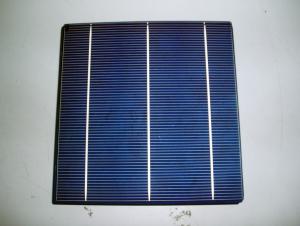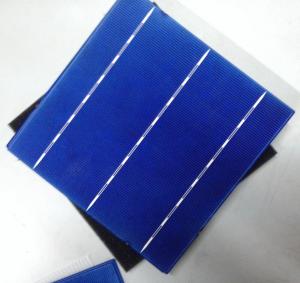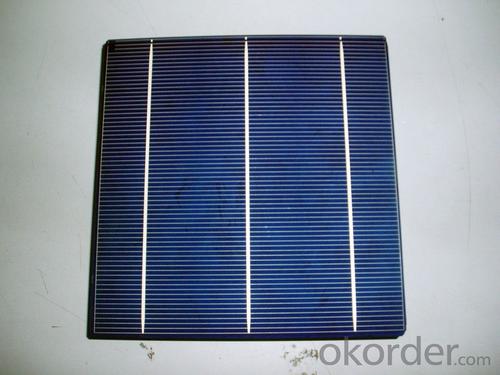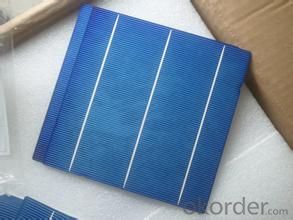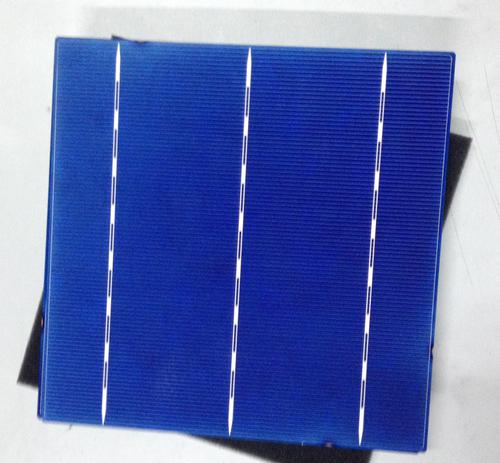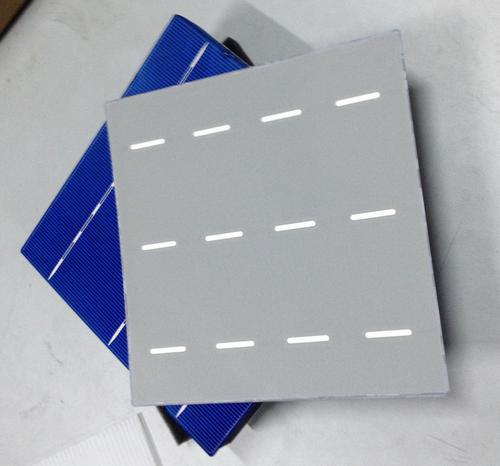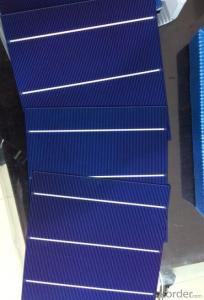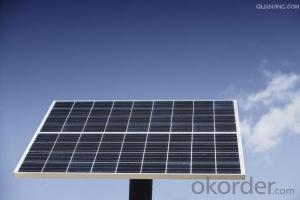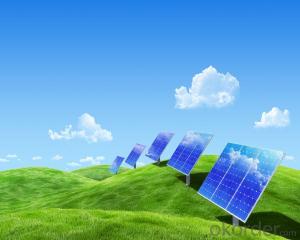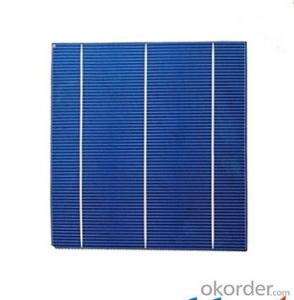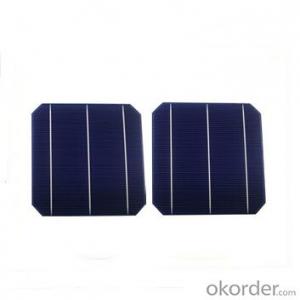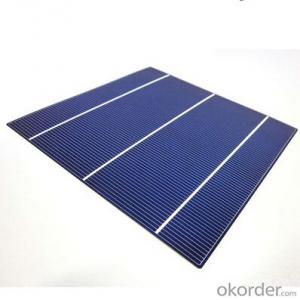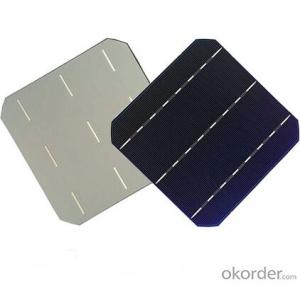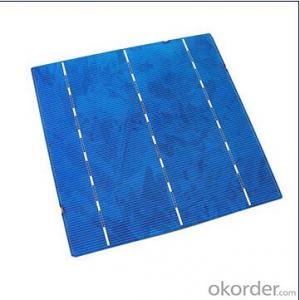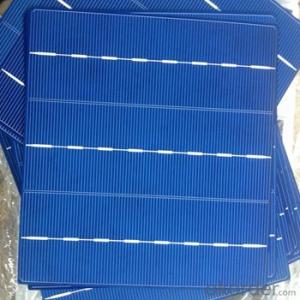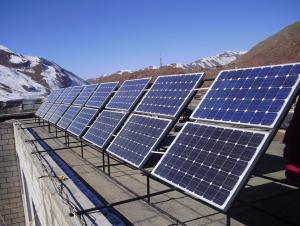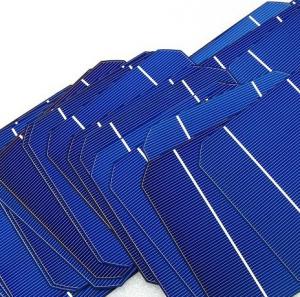III-V Solar Cells - Polycrystalline Solar Cells, Good Quality, Stable Supply, 17.4% Efficiency
- Loading Port:
- China Main Port
- Payment Terms:
- TT or LC
- Min Order Qty:
- 5000 pc
- Supply Capability:
- -
OKorder Service Pledge
OKorder Financial Service
You Might Also Like
Brief Introduction of Solar Cells
A solar cell, is an electrical device that converts the energy of light directly into electricity by the photovoltaic effect, which is a physical and chemical phenomenon. It is a form of photoelectric cell, defined as a device whose electrical characteristics, such as current, voltage, or resistance, vary when exposed to light. Solar cells are the building blocks of photovoltaic modules, otherwise known as solar panels.
Specifications of Polycrystalline Solar Cells
Format : 156 mm × 156 mm ± 0.5 mm
Thickness: 210 μm ±40 μm
Front (-) : 1.5mm bus bars (silver),blue anti-reflection coating (silicon nitride)
Back (+) : 2.5mm wide soldering pads (silver) back surface field (aluminium)
Efficiency (%) | Pmpp (W) | Umpp (V) | Impp (A) | Voc (V) | Isc (A) |
18.00% | 4.38 | 0.528 | 8.291 | 0.631 | 8.869 |
17.80% | 4.33 | 0.525 | 8.252 | 0.629 | 8.821 |
17.60% | 4.29 | 0.532 | 8.053 | 0.633 | 8.541 |
17.40% | 4.23 | 0.528 | 8.092 | 0.624 | 8.632 |
17.20% | 4.19 | 0.524 | 7.992 | 0.62 | 8.458 |
17.00% | 4.14 | 0.52 | 7.972 | 0.623 | 8.5 |
Advantage of Polycrystalline Solar Cells
Tire-1 Solar Cells’ Manufacturer Quality Guarantee. With a complete and sophisticated quality government system, our Quality Management have arrived world’s leading place. Customer can receive Tire-1 Cells Maker’s Quality Standard Products.
Trusted Warranty. We can supply trusted after-sales service to our customer. If our cells are found not in conformity to the specification of manufacturer, or should the inspected quantity found in shortage, or should the packing found damaged, the buyer has the right to claim to the seller. The claim, if any, should be presented to seller within 30 days after cargo's arrival date to the port, together with related inspection report and photos issued and provided by a reputable independent surveyor such as SGS.
World’s Leading Manufacturer Equipment. We imported the newest and leading production equipment from abroad. Advanced equipment can guarantee the stable quality of cells. Auto production line can also save labor cost which will further cut our production cost.
Bulk supply: With the production capacity of 500MW, we can produce large quantity every month. This can satisfy most customer requirement.
Usage of Polycrystalline Solar Cells
Solar cells are often electrically connected and encapsulated as a module. Photovoltaic modules often have a sheet of glass on the front (sun up) side, allowing light to pass while protecting the semiconductor wafers from abrasion and impact due to wind-driven debris, rain, hail, etc. Solar cells are also usually connected in series in modules, creating an additive voltage. Connecting cells in parallel will yield a higher current; our solar cells have passed IEC Certification. With high and stable quality, our cells can greatly improve the performance of Solar Modules.
Applications of Polycrystalline Solar Cells
Assemblies of photovoltaic cells are used to make solar modules which generate electrical power from sunlight, as distinguished from a "solar module" or "solar panel". A solar array generates solar power using solar energy.
Packaging & Delivery of Polycrystalline Solar Cells
Carton Box Package and Deliver by air. It should be noticed that it should be avoid of water, sunshine and moist.
Factory Picture of Solar Cells
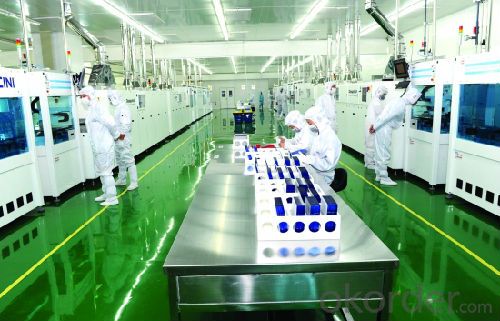
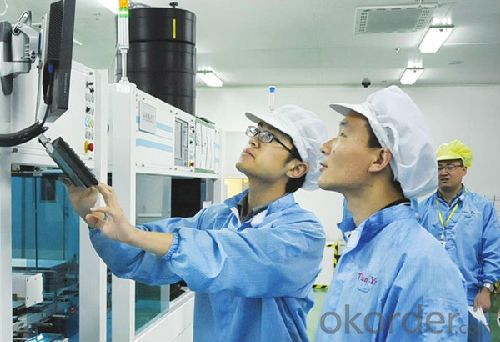

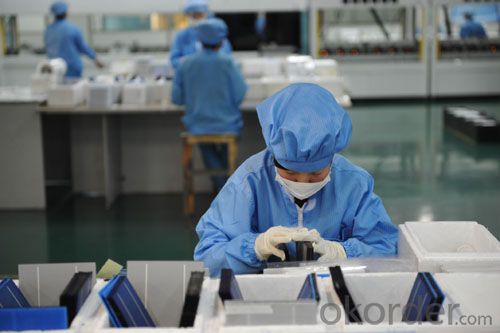
FAQ
We have organized several common questions for our clients,may help you sincerely:
1. What’s price per Watt?
A: It’s depends on the quantity, delivery date and payment terms of the order. We can talk further about the detail price issue. Our products is high quality with lower price level.
2. Can you tell me the parameter of your solar cells?
We have different series of cells with different power output, both from c-si to a-si. Please take our specification sheet for your reference.
3.How do you pack your products?
We have rich experience on how to pack the panels to make sure the safety on shipment when it arrives at the destination.
4.Can you do OEM for us?
Yes, we can.
5.How long can we receive the product after purchase?
In the purchase of product within three working days, We will arrange the factory delivery as soon as possible. The perfect time of receiving is related to the state and position of customers. Commonly 7 to 10 working days can be served.
- Q: What is the impact of hailstorms on solar cells?
- Hailstorms can have a significant impact on solar cells. The high-speed impact of hailstones can cause physical damage, such as cracks or fractures, to the surface of solar panels. This can result in reduced efficiency and output of the affected solar cells. Additionally, hailstorms can also damage the protective layers on solar panels, increasing the risk of moisture ingress and potential corrosion. Therefore, hailstorms pose a potential threat to the durability and performance of solar cells.
- Q: Can solar cells be used in off-grid systems?
- Yes, solar cells can definitely be used in off-grid systems. In fact, they are one of the most common and efficient sources of renewable energy for off-grid applications. Solar cells, also known as photovoltaic cells, generate electricity from sunlight and can be used to power various devices and systems in remote areas where there is no access to the electric grid. They are reliable, environmentally friendly, and can provide a sustainable energy solution for off-grid living or remote locations.
- Q: Are solar cells weather-resistant?
- Yes, solar cells are weather-resistant. They are designed to withstand various weather conditions such as rain, snow, heat, and cold. However, extreme weather events like hurricanes or hailstorms can potentially damage solar cells.
- Q: Can solar cells be used in public transportation systems?
- Yes, solar cells can be used in public transportation systems. They can be installed on the roofs of buses, trains, and trams to generate electricity from sunlight, which can be used to power various systems such as lighting, air conditioning, and onboard electronics. This helps reduce reliance on fossil fuels and lowers the carbon footprint of public transportation. Additionally, solar cells can also be integrated into bus shelters and charging stations to provide clean energy for electric buses and other vehicles.
- Q: What is the impact of leaf litter on solar cell performance?
- Leaf litter can have a negative impact on solar cell performance as it can block sunlight from reaching the surface of the cells, reducing their efficiency and overall power output. Additionally, the buildup of leaf litter can also lead to overheating and potential damage to the solar panels. Regular cleaning and maintenance of solar panels are crucial to ensure optimal performance and maximize energy generation.
- Q: Can solar cells be used for portable devices?
- Yes, solar cells can be used for portable devices. They are commonly used in small electronic gadgets such as smartphones, tablets, and portable chargers to harness solar energy and convert it into electrical power. This enables the devices to be charged or powered by sunlight, making them convenient and environmentally-friendly options for on-the-go usage.
- Q: What diode does the solar panel use?
- The main difference between the two diodes in the application of solar energy is the conduction voltage drop, the Schottky 0.4V or so, the ordinary 0.7V or so, mainly depends on your solar cell output voltage, if the solar cell voltage is lower than 5V or even 2V
- Q: How do solar cells affect the environment?
- Solar cells have a positive impact on the environment as they generate electricity from a renewable source, the Sun, without emitting greenhouse gases or harmful pollutants. This reduces reliance on fossil fuels, mitigates air and water pollution, and contributes to the fight against climate change. Additionally, solar energy does not require water for operation, which helps conserve this precious resource. Although there are some environmental concerns related to the production and disposal of solar cells, the overall benefits greatly outweigh these drawbacks.
- Q: What is the expected degradation rate of a solar cell?
- The expected degradation rate of a solar cell can vary depending on various factors such as the quality of materials used, manufacturing processes, environmental conditions, and maintenance practices. However, on average, a well-designed and properly maintained solar cell can experience an annual degradation rate of around 0.5% to 1%. This means that over time, the solar cell's efficiency may decrease by 0.5% to 1% per year.
- Q: Solar cells and the difference between ordinary batteries. Why is the solar cell is converted into electrical energy, zinc battery is what is converted into chemical energy
- The so-called chemical energy, in fact, is "chemical potential". Can be released through the oxidation-reduction reaction of energy, into other energy. This is the release of chemical energy.
Send your message to us
III-V Solar Cells - Polycrystalline Solar Cells, Good Quality, Stable Supply, 17.4% Efficiency
- Loading Port:
- China Main Port
- Payment Terms:
- TT or LC
- Min Order Qty:
- 5000 pc
- Supply Capability:
- -
OKorder Service Pledge
OKorder Financial Service
Similar products
Hot products
Hot Searches
Related keywords
